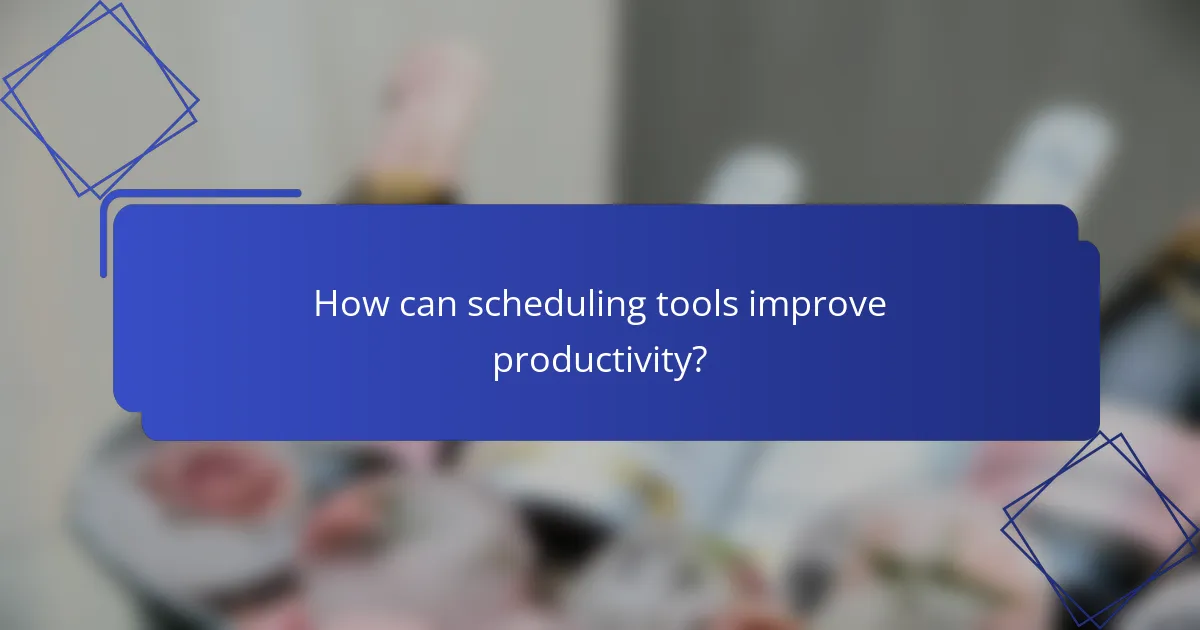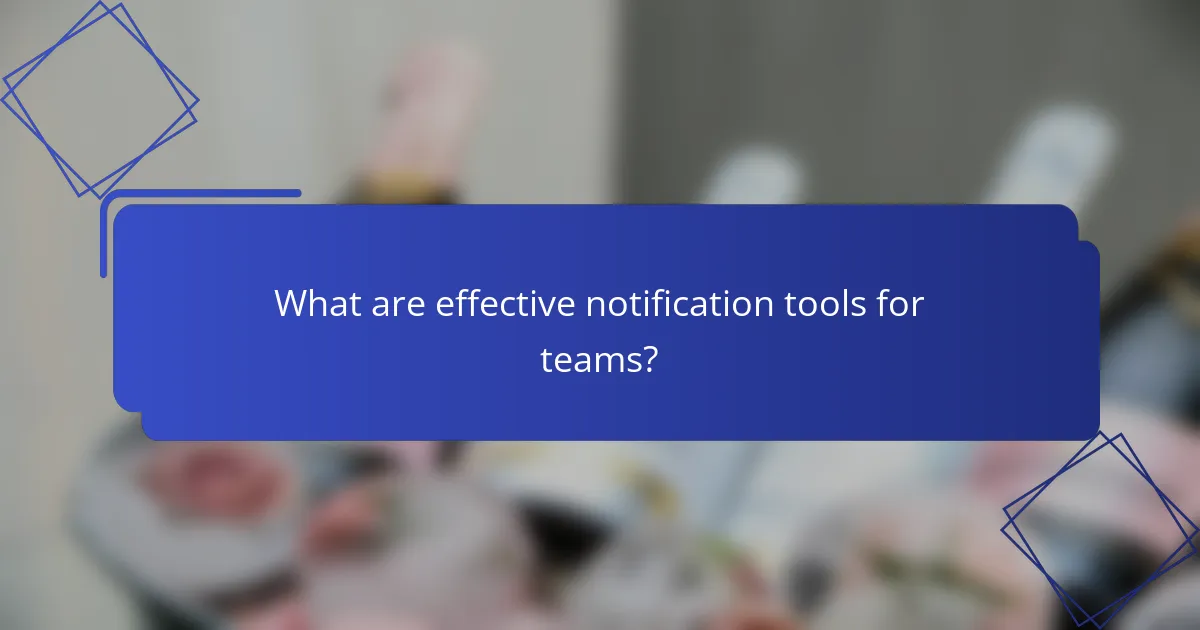In today’s fast-paced digital landscape, online tools for tracking, scheduling, and notifications are essential for optimizing productivity and decision-making. Tracking tools provide valuable insights into user behavior and performance metrics, while scheduling tools simplify the organization of tasks and meetings. Additionally, effective notification systems enhance team communication, ensuring that critical updates are communicated promptly and efficiently.
![]()
What are the best online tools for tracking?
The best online tools for tracking provide insights into user behavior, website performance, and marketing effectiveness. These tools help businesses make data-driven decisions by offering analytics, reporting, and real-time monitoring capabilities.
Google Analytics
Google Analytics is a widely used web analytics service that tracks and reports website traffic. It offers features such as real-time data, audience segmentation, and conversion tracking, making it essential for businesses aiming to optimize their online presence.
To get started, create an account, add the tracking code to your website, and set up goals to measure specific actions. Be mindful of privacy regulations like GDPR when collecting user data.
HubSpot Tracking Software
HubSpot Tracking Software integrates marketing, sales, and service tools to provide comprehensive tracking capabilities. It allows users to monitor website interactions, email performance, and lead generation metrics.
Utilizing HubSpot requires setting up tracking codes and connecting your marketing assets. This tool is particularly beneficial for inbound marketing strategies, as it helps identify which content drives conversions.
Clicky
Clicky is a real-time web analytics tool that focuses on simplicity and ease of use. It provides detailed insights into visitor behavior, including heatmaps and individual user tracking.
To leverage Clicky effectively, install the tracking code on your site and explore its user-friendly dashboard. Clicky is ideal for small to medium-sized businesses looking for straightforward analytics without the complexity of larger platforms.
Mixpanel
Mixpanel specializes in product analytics, focusing on user engagement and retention. It allows businesses to track events and analyze user flows, providing insights into how users interact with products.
Setting up Mixpanel involves defining events and properties to track. This tool is particularly useful for SaaS companies aiming to improve user experience and increase customer lifetime value through data-driven decisions.

How can scheduling tools improve productivity?
Scheduling tools enhance productivity by streamlining the process of organizing meetings and tasks, reducing the time spent on back-and-forth communications. They allow users to efficiently allocate their time, prioritize tasks, and manage deadlines, ultimately leading to better time management and increased focus on essential activities.
Calendly
Calendly is an online scheduling tool that simplifies the process of booking meetings. Users can set their availability preferences, and Calendly generates a personalized link that others can use to schedule appointments without the hassle of email exchanges.
To maximize its effectiveness, integrate Calendly with your calendar applications like Google Calendar or Outlook. This ensures that your availability is always up-to-date, preventing double bookings and allowing for seamless scheduling.
Common pitfalls include not updating your availability regularly or failing to communicate the scheduling link to all relevant parties. Make sure to share the link widely to reduce scheduling conflicts.
Asana
Asana is a project management tool that helps teams organize tasks, set deadlines, and track progress. It allows users to create projects, assign tasks, and set due dates, fostering collaboration and accountability among team members.
To improve productivity, utilize Asana’s features like task dependencies and project timelines. This helps in visualizing project flow and identifying potential bottlenecks early on. Regularly review and adjust tasks to keep the project on track.
Avoid overwhelming your team with too many tasks at once. Prioritize and break down larger projects into manageable steps to maintain focus and momentum.
Trello
Trello is a visual project management tool that uses boards, lists, and cards to organize tasks and workflows. Users can easily move cards between lists to reflect progress, making it intuitive for tracking project stages.
To make the most of Trello, customize boards with labels, due dates, and checklists. This enhances clarity and helps team members understand their responsibilities at a glance. Regularly update boards to reflect current project status.
Be cautious of creating too many boards or lists, which can lead to confusion. Keep your Trello workspace organized and focused on key projects to maintain productivity and clarity.

What are effective notification tools for teams?
Effective notification tools for teams streamline communication and ensure that important updates are not missed. These tools help manage alerts, reminders, and messages, enhancing collaboration and productivity within a team environment.
Slack Notifications
Slack notifications allow teams to receive real-time updates on messages, mentions, and channel activity. Users can customize their notification preferences, choosing to receive alerts for all messages, only direct mentions, or none at all during specific hours.
To optimize Slack notifications, consider setting up keyword alerts for important topics or projects. This ensures that crucial discussions are highlighted without overwhelming users with constant updates. Remember to periodically review notification settings to align with changing team dynamics.
Microsoft Teams Alerts
Microsoft Teams alerts provide a robust system for notifying users about chats, meetings, and file updates. Teams can configure notifications at the channel level, allowing for tailored alerts based on project needs or team priorities.
Utilizing the “Do Not Disturb” feature can help maintain focus during critical work periods while still allowing for important notifications to come through. Encourage team members to adjust their notification settings based on their roles to enhance overall communication efficiency.
Pushbullet
Pushbullet is a versatile tool that enables users to send notifications across devices, making it easier to stay connected. It integrates with various applications, allowing alerts from emails, messages, and even social media to be consolidated in one place.
To make the most of Pushbullet, set up specific channels for different types of notifications, such as work-related alerts versus personal updates. This organization helps prevent distraction and ensures that users only receive relevant information when needed. Regularly check integration settings to keep notifications aligned with current workflows.
![]()
What criteria should you consider when choosing a tracking tool?
When selecting a tracking tool, consider integration capabilities, user interface, and cost-effectiveness. These factors will significantly impact how well the tool meets your needs and fits into your existing workflow.
Integration capabilities
Integration capabilities refer to how well the tracking tool can connect with other software and platforms you use. Look for tools that offer seamless connections with popular applications like project management software, email services, and customer relationship management (CRM) systems.
For example, a tracking tool that integrates with tools like Slack or Trello can enhance collaboration and streamline communication. Ensure the tool supports APIs or has pre-built integrations to avoid manual data entry and improve efficiency.
User interface
A user-friendly interface is crucial for ensuring that all team members can easily navigate and utilize the tracking tool. A clean, intuitive design reduces the learning curve and encourages consistent use.
Consider tools that offer customizable dashboards and clear visualizations of data. A good interface should allow users to quickly access key features and insights without overwhelming them with unnecessary information.
Cost-effectiveness
Cost-effectiveness involves evaluating whether the tracking tool provides good value for its price. Compare subscription plans and features to determine if the tool meets your needs without exceeding your budget.
Look for tools that offer tiered pricing based on usage or features, allowing you to choose a plan that fits your organization’s size and requirements. Free trials can also help you assess the tool’s value before committing financially.

How do scheduling tools vary by industry?
Scheduling tools differ significantly across industries, tailored to meet specific operational needs and regulatory requirements. Each sector employs unique features to enhance efficiency, improve communication, and ensure compliance with relevant standards.
Healthcare scheduling software
Healthcare scheduling software is designed to manage appointments for patients and healthcare providers, focusing on optimizing patient flow and resource allocation. These tools often include features like automated reminders, patient self-scheduling, and integration with electronic health records (EHR).
When selecting healthcare scheduling software, consider compliance with regulations such as HIPAA in the U.S. or GDPR in Europe, which govern patient data privacy. Look for systems that offer secure communication channels and robust reporting capabilities to track appointment metrics.
Education scheduling platforms
Education scheduling platforms facilitate the organization of classes, exams, and events within educational institutions. These tools often provide functionalities for student registration, course management, and faculty scheduling, ensuring that resources are effectively allocated.
In the education sector, it’s crucial to choose platforms that can handle varying academic calendars and accommodate last-minute changes. Features like automated notifications for students and faculty can enhance communication and reduce scheduling conflicts.
Corporate meeting schedulers
Corporate meeting schedulers are tools designed to streamline the process of organizing meetings, whether in-person or virtual. These platforms typically include calendar integrations, availability checks, and options for sending invitations and reminders.
When using corporate meeting schedulers, prioritize tools that offer compatibility with existing calendar systems like Google Calendar or Outlook. Additionally, consider features that allow for time zone adjustments, especially in global organizations, to ensure all participants can join without confusion.
![]()
What are the emerging trends in online tracking and scheduling tools?
Emerging trends in online tracking and scheduling tools focus on automation, integration, and user-centric design. These tools are increasingly leveraging artificial intelligence to enhance efficiency and improve user experience.
Integration with AI and Machine Learning
AI and machine learning are transforming tracking and scheduling tools by automating repetitive tasks and predicting user needs. For instance, some applications can analyze past behavior to suggest optimal meeting times or track project progress more effectively.
Consider tools that use AI to streamline workflows, such as automatically rescheduling meetings based on availability or sending reminders based on user habits. This not only saves time but also reduces the cognitive load on users.
Focus on User Experience and Accessibility
Modern tracking and scheduling tools prioritize user experience, ensuring that interfaces are intuitive and accessible. This includes mobile-friendly designs and features that cater to diverse user needs, such as voice commands and customizable dashboards.
When selecting a tool, look for those that offer easy navigation and clear visualizations of schedules. A user-friendly interface can significantly enhance productivity and reduce frustration.
Real-Time Collaboration Features
Real-time collaboration is becoming essential in online tracking and scheduling tools, enabling teams to work together seamlessly. Features like shared calendars, live updates, and instant notifications help keep everyone on the same page.
Choose tools that allow for easy sharing of schedules and project timelines. This ensures that all team members are aware of changes and can adjust their plans accordingly, fostering better communication and teamwork.
Data Privacy and Security Enhancements
As online tracking and scheduling tools handle sensitive information, data privacy and security are critical concerns. Emerging tools are implementing stronger encryption methods and compliance with regulations such as GDPR to protect user data.
When evaluating tools, prioritize those that offer robust security features, such as two-factor authentication and regular security audits. This will help safeguard your information and maintain user trust.


